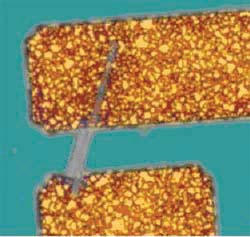Home > Press > China's first ZnO nanorod field-effect transistor fabricated in IMECAS
 |
| China's first back-gate ZnO nanorod field-effect transistor |
Abstract:
Recently, zinc oxide (ZnO) nanorod field-effect transistor (FET), the first of its kind as a nano device in China, was successfully fabricated by scientists with the CAS Institute of Microelectronics, Chinese Academy of Sciences (IME).
China's first ZnO nanorod field-effect transistor fabricated in IMECAS
China | Posted on October 22nd, 2008 ZnO is a wide bandgap semiconductor and an important multifunctional material. The ZnO nano materials, such as nanowires, nanorods, nanobands and nanorings, attract intense worldwide attention for their unique optical, semiconducting and piezoelectric properties. At present, Chinese scientists in this filed mainly focus their research on material growth and diode development.
A research group headed by Prof. ZHANG Haiying from IME came up with a unique "bottom-up" method for designing and developing nano devices. Through the regular contact photolithography technology, they employed ZnO nanorods as the channel material and fabricated a metal-oxide-semiconductor FET by combining gate oxide and back gate metal, which displayed satisfying results.
Next, Prof. Zhang and her colleagues will further advance the technology in order to develop nanowires with an even smaller diameter and improve the performance of the devices, raising solutions to key problems in practical use.
####
About Chinese Academy of Sciences
CAS strives to build itself into a scientific research base at advanced international level, a base for fostering and bringing up advanced S&T talents, and a base for promoting the development of China's high and new technology industries. By 2010, CAS will have about 80 national institutes noted for their powerful capacities in S&T innovation and sustainable development or with distinctive features; thirty of them will become internationally acknowledged, high-level research institutions, and three to five will be world class.
For more information, please click here
Contacts:
Chinese Academy of Sciences
Add: 52 Sanlihe Rd., Beijing China
Postcode: 100864
Tel: 86 10 68597289
Fax: 86 10 68512458
Chief-Editor's Information:
Guo Haiyan
the Editor
Bulletin of Chinese Academy of Sciences
CAS Institute of Policy & Management,
P.O.Box 8712, Beijing 100080, China.
Copyright © Chinese Academy of Sciences
If you have a comment, please Contact us.Issuers of news releases, not 7th Wave, Inc. or Nanotechnology Now, are solely responsible for the accuracy of the content.
| Related News Press |
News and information
![]() Researchers develop molecular qubits that communicate at telecom frequencies October 3rd, 2025
Researchers develop molecular qubits that communicate at telecom frequencies October 3rd, 2025
![]() Next-generation quantum communication October 3rd, 2025
Next-generation quantum communication October 3rd, 2025
![]() "Nanoreactor" cage uses visible light for catalytic and ultra-selective cross-cycloadditions October 3rd, 2025
"Nanoreactor" cage uses visible light for catalytic and ultra-selective cross-cycloadditions October 3rd, 2025
Chip Technology
![]() Lab to industry: InSe wafer-scale breakthrough for future electronics August 8th, 2025
Lab to industry: InSe wafer-scale breakthrough for future electronics August 8th, 2025
![]() A 1960s idea inspires NBI researchers to study hitherto inaccessible quantum states June 6th, 2025
A 1960s idea inspires NBI researchers to study hitherto inaccessible quantum states June 6th, 2025
![]() Programmable electron-induced color router array May 14th, 2025
Programmable electron-induced color router array May 14th, 2025
Discoveries
![]() Researchers develop molecular qubits that communicate at telecom frequencies October 3rd, 2025
Researchers develop molecular qubits that communicate at telecom frequencies October 3rd, 2025
![]() Next-generation quantum communication October 3rd, 2025
Next-generation quantum communication October 3rd, 2025
![]() "Nanoreactor" cage uses visible light for catalytic and ultra-selective cross-cycloadditions October 3rd, 2025
"Nanoreactor" cage uses visible light for catalytic and ultra-selective cross-cycloadditions October 3rd, 2025
Announcements
![]() Rice membrane extracts lithium from brines with greater speed, less waste October 3rd, 2025
Rice membrane extracts lithium from brines with greater speed, less waste October 3rd, 2025
![]() Researchers develop molecular qubits that communicate at telecom frequencies October 3rd, 2025
Researchers develop molecular qubits that communicate at telecom frequencies October 3rd, 2025
![]() Next-generation quantum communication October 3rd, 2025
Next-generation quantum communication October 3rd, 2025
![]() "Nanoreactor" cage uses visible light for catalytic and ultra-selective cross-cycloadditions October 3rd, 2025
"Nanoreactor" cage uses visible light for catalytic and ultra-selective cross-cycloadditions October 3rd, 2025
|
|
||
|
|
||
| The latest news from around the world, FREE | ||
|
|
||
|
|
||
| Premium Products | ||
|
|
||
|
Only the news you want to read!
Learn More |
||
|
|
||
|
Full-service, expert consulting
Learn More |
||
|
|
||








